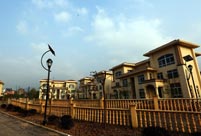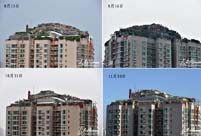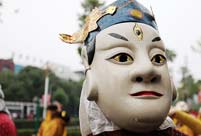SINGAPORE, Dec. 3 -- Tianjin Eco-City, the best known eco-city project in China, now has about 6,000 residents five years after its construction, according to Ho Tong Yen, chief executive officer of Sino-Singapore Tianjin Eco-city Investment and Development Co., Ltd, the project's developer.
In a recent interview with Xinhua, Ho said that he has started to see long queues at the canteen for lunch in the eco-city.
"Now we have some 4,000 people working there and some 6,000 residents that include employees of companies located in the site and the local government. What we have seen is that the place is becoming lively day by day," he said.
Ho said that that they don't have a specific number of people who would eventually live in the eco-city but the environment- friendly metropolis could accommodate as many as 350,000 people when it is fully completed in 2020.
The Tianjin Eco-City was the result of a joint proposal in 2007 by then Chinese Premier Wen Jiabao and Singapore's former Senior Minister Goh Chok Tong to build a city that is socially harmonious, environmentally-friendly, resource-efficient and a model for sustainable development.
Unlike most eco-cities elsewhere in the world that are usually small pilot projects, the Tianjin eco-city, located 40 km from the center of China's northeastern coastal megacity of Tianjin, is planned to become a full city on a land of 30 square kilometers.
According to Ho, so far eight square kilometers, or about a fourth of the total land area in the eco-city has been developed but not all of the developed areas are occupied since many lots are reserved for future use.
Though still a fledgling town, the Tianjin eco-city is regarded as one closest to the concept of an ecological city that has been envisioned by Richard Register, an American author.
During the interview, Ho showed aerial shots of the eco-city as well as its green spaces, restored wetland, an eco-valley, bicycle tracks, wind turbines, skating park, an international school, kindergarten and office buildings.
Before its development, the site was barren land with some salt beds and a polluted body of water that includes a 2.6 square kilometers of wastewater pond.
There are now some 1,000 companies registered in the eco-city, Ho said, adding that he expects more commercial establishments and residents to move in especially when a light rail system is already in place.
The city has amenities for modern living such as a golf course and a lot of open spaces with a lot of greeneries to encourage people to walk.
When asked to name the place he likes best in the Tianjin Eco- City, Ho said that he is proud of the entire city, block by block. "It's like seeing a baby growing up," he said.
Ho, who took over as CEO of the joint venture in 2010, said that the construction of the Tianjin Eco-City is aimed at realizing the vision of both China and Singapore to achieve sustainable development without harming the environment.
The eco-city has a set of 22 quantitative and four qualitative indicators covering various aspects of sustainable development and all buildings will have to comply with green standards, Ho said.
For example, one of the schools in the eco-city has a wall that indicates the amount of energy the building uses so that the kids will have anactual experience on how to lead an ecological life.
"The emphasis is different depending on our progress in buildingthe city. At first it may be the design, and then technologies, and the policies, and eventually it would be more important to advocate amore sustainable way of living when more and more people move in," Hosaid.
Despite its somewhat high-tech name, the Tianjin Eco-City is closest to the Tampines, a new town in Singapore, Ho said.
"We are, in a sense, quite like other cities, that is, if you don't look into the details, like the materials we use," he said.
The eco-city is planned for 350,000 people, with about 40 percent of the land for residential purposes, 10 percent for sustainable industries and 3 percent for commercial businesses.
 Heavy cargo flights taking off
Heavy cargo flights taking off In pictures: PLA's digital equipment
In pictures: PLA's digital equipment  Americans mark Thanksgiving Day with parades
Americans mark Thanksgiving Day with parades Self-made farmer billionaire donates 69 villas at hometown
Self-made farmer billionaire donates 69 villas at hometown Demolition of bizarre rooftop villa in Beijing still in progress
Demolition of bizarre rooftop villa in Beijing still in progress Service seminar for E China train attendants
Service seminar for E China train attendants  China's first nude photographer
China's first nude photographer Selected sports photos of the week
Selected sports photos of the week Treasure of Chinese culture- Nuo Dance
Treasure of Chinese culture- Nuo Dance  Youths in Night club: photo story
Youths in Night club: photo story Models dazzle at Int'l Yacht Model Pageant
Models dazzle at Int'l Yacht Model Pageant  Crystal scenery in China: Jilin fog glaze
Crystal scenery in China: Jilin fog glaze  Tianjin holds first pole dance championship
Tianjin holds first pole dance championship  Annual Santa Claus parade held in Canada's Montreal
Annual Santa Claus parade held in Canada's Montreal China's aircraft carrier passes through Taiwan Strait
China's aircraft carrier passes through Taiwan StraitDay|Week|Month